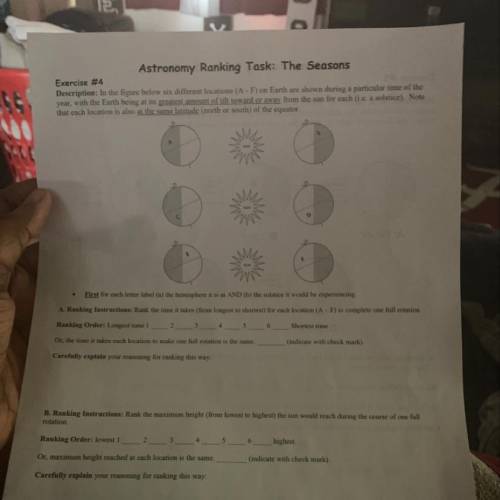Astronomy Ranking Task: The Seasons
Exercise #4
Description: In the figure below six dif...

Biology, 12.02.2020 19:54 KAITLYN007
Astronomy Ranking Task: The Seasons
Exercise #4
Description: In the figure below six different locations (A - F) on Earth are shown during a particular time on
with the Earth being at its greatest amount of tilt toward or away from the sun for each i. e. a solstice). Note
that each location is also at the same latitude (north or south) of the equator.
•
First for each letter label (a) the hemisphere it is in AND (b) the solstice it would be experiencing.
A. Ranking Instructions: Rank the time it takes (from longest to shortest) for each location (A-F) to complete one full rotation.
Ranking Order: Longest time 1/
2_
3_
_4_
_5__6_
_Shortest time
Or, the time it takes each location to make one full rotation is the same.
(indicate with check mark).
Carefully explain your reasoning for ranking this way:
B. Ranking Instructions: Rank the maximum height (from lowest to highest) the sun would reach during the course of one full
rotation.
Ranking Order: lowest 1_
2_
3_
5_
6_
highest.
Or, maximum height reached at each location is the same.
(indicate with check mark).
Carefully explain your reasoning for ranking this way:


Answers: 1


Another question on Biology

Biology, 22.06.2019 03:50
Explain how the political influence of african americans leaders became weaker.
Answers: 2

Biology, 22.06.2019 07:30
The ancestors of plants that lived in water had plenty of water for the young. angiosperms are a group of land plants that evolved a reproductive trait for living on land. this trait protect young plants by allowing them to grow only when water is present and the conditions for healthy development are right. what trait most likely young angiosperms in this way?
Answers: 1

Biology, 22.06.2019 12:30
In meiosis ii during anaphase ii which structures separated homologous chromosomes or sister chromatids
Answers: 1

Biology, 22.06.2019 13:20
Imagine a self-reactive t cell that has not undergone clonal deletion in the thymus (that is to say, it has escaped central tolerance). if it encounters self antigen in the absence of an infection or inflammation, what will happen to this self-reactive t cell? (select two answers) (a) the t cell undergoes clonal expansion. (b) the t cell gains effector functions. (c) the t cell undergoes apoptosis. (d) the t cell becomes activated. (e) the t cell becomes anergic.
Answers: 1
You know the right answer?
Questions

Physics, 27.07.2019 05:30

Biology, 27.07.2019 05:30




Chemistry, 27.07.2019 05:30




Physics, 27.07.2019 05:30



World Languages, 27.07.2019 05:30


Business, 27.07.2019 05:30


Social Studies, 27.07.2019 05:30



Physics, 27.07.2019 05:30



